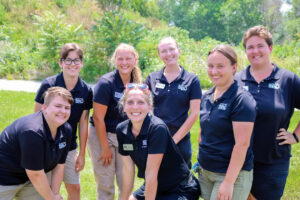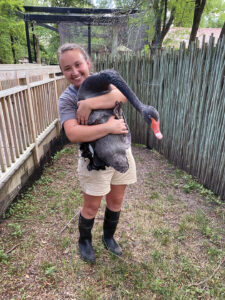Behind the scenes with a zookeeper
1/31/2024
Amara Austin, second from the right, says being a zookeeper is special, but being able to work with the people on her team makes the experience exponentially more enjoyable. Photo by Mikayla Dehnke.
If you have spent any time in Des Moines, it’s almost a certainty you have been to the Blank Park Zoo. It’s been open since the mid 1960s and has been home to a countless number of animals throughout the years, courtesy of the zookeepers who work mostly behind the scenes.
Amara Austin is the lead bird and reptile keeper at the Blank Park Zoo. She’s from Boone, graduated from Iowa State University, and interned at the Big Cat Sanctuary in Texas. Austin spent a lot of her undergrad at Blank, working on education programs, summer camps, early childhood classes and more. After spending time in Minnesota, she rejoined the Blank team for a seasonal position on the bird team, then eventually became a full-time keeper. She is now the lead bird and reptile keeper and has been since August 2023.
What originally got her into the zookeeping world?
“I thought I wanted to go to vet school, and then I hit organic chemistry in college and I was like, that’s too much for me,” she said.
Austin wasn’t a big fan of birds before her current position, but the time she’s spent with them has changed her perspective.
“All of our birds have such big personalities, and they’re all so different,” she said. “They’re so funny to watch. I think people don’t appreciate that about birds, but they’re very unique and different from other animals that you might find.”
Her passion for the birds at the zoo was evident by the detail she went into about some of her favorite birds she works with. From birds being timid or too friendly, Austin does have one feathery friend that sticks out above the rest.

Amara Austin’s long-term goal for the field is to become an animal care director. Photo courtesy of Amara Austin.
“My No. 1 favorite is probably our female cassowary, Sydney. I train her, and she just has a very big personality. Some people are probably like, ‘Oh, she’s just being mean to you,’ and I’m like, ‘No, she’s just a spunky bird, and she just wants to see what you’re doing,’ ” Austin said.
Your pet at home likely has favorites, and it’s no different at the zoo. Austin says some of the birds she works with respond differently to certain trainers; however, they all warm up to everyone eventually (with food).
Since Austin has spent time in multiple locations, she’s been able to work with some “out-of-the-box” animals.
“There were about 31 or 32 bears at that sanctuary in Texas. My favorite was a grizzly bear named Spearmint. He would always sit in his water bowl. He was really cute and was one of my favorites,” she said.
Other favorites she has worked with are a bearded dragon named Beaker, giant African millipedes, a white tiger named Arusha that was always “chuffing” (an affectionate sound made by tigers) at her, an Australian wood duck in the Discovery Center, and everyone’s favorite, Barnaby, the largest Aldabra tortoise at the zoo that loves neck scratches.
The desire to take care of and watch over interesting creatures is one many people have while growing up. What isn’t thought of too often, though, are the difficult challenges that arise in this line of work. Austin mentions handling an upsetting moment with one of her favorite birds.
“Our female bush thick-knee, she had collapsed on exhibit one day. It just ended up that she just had a calcium deficiency. We were able to resolve the issue very quickly, but it was really hard for me seeing her in that state,” Austin said.
Nevertheless, with the challenges also come successes.
“One thing I was especially proud of, in addition to the training successes, was successfully growing hydroponic barley grass during HPAI (highly pathogenic avian influenza). It provided a great enrichment opportunity for all of our birds, plus it’s a great addition to the tortoise diet. I was also able to offer it to four other teams as enrichment for their animals,” she said.
While they try to stick to routines as much as possible, it isn’t always that simple when working with animals.
“We try to be organized, but the animals definitely throw everything they have at us. We can plan and plan and plan and plan all we want, but the animals are in control. If they decide that they don’t want to cooperate that day, then that is just something that we have to roll with. I think definitely being flexible is the biggest part of working at a zoo,” she said. ♦























